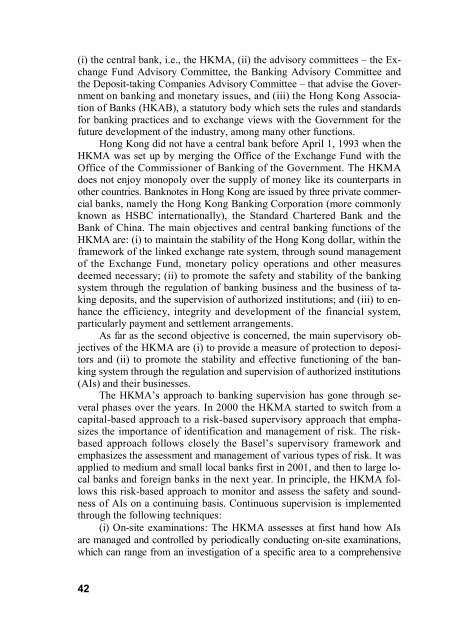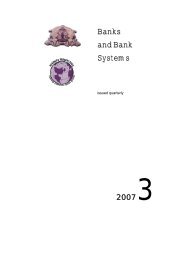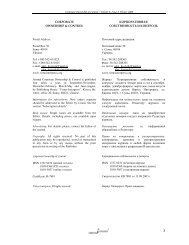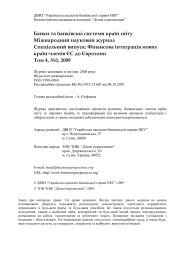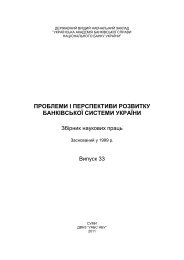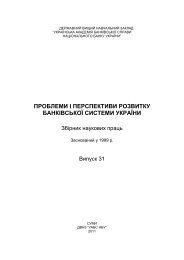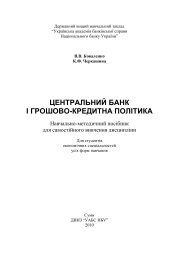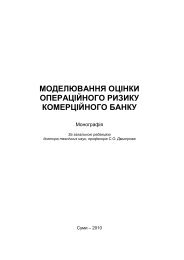BASEL II: PROBLEMS AND USAGE
BASEL II: PROBLEMS AND USAGE
BASEL II: PROBLEMS AND USAGE
Create successful ePaper yourself
Turn your PDF publications into a flip-book with our unique Google optimized e-Paper software.
(i) the central bank, i.e., the HKMA, (ii) the advisory committees – the Exchange<br />
Fund Advisory Committee, the Banking Advisory Committee and<br />
the Deposit-taking Companies Advisory Committee – that advise the Government<br />
on banking and monetary issues, and (iii) the Hong Kong Association<br />
of Banks (HKAB), a statutory body which sets the rules and standards<br />
for banking practices and to exchange views with the Government for the<br />
future development of the industry, among many other functions.<br />
Hong Kong did not have a central bank before April 1, 1993 when the<br />
HKMA was set up by merging the Office of the Exchange Fund with the<br />
Office of the Commissioner of Banking of the Government. The HKMA<br />
does not enjoy monopoly over the supply of money like its counterparts in<br />
other countries. Banknotes in Hong Kong are issued by three private commercial<br />
banks, namely the Hong Kong Banking Corporation (more commonly<br />
known as HSBC internationally), the Standard Chartered Bank and the<br />
Bank of China. The main objectives and central banking functions of the<br />
HKMA are: (i) to maintain the stability of the Hong Kong dollar, within the<br />
framework of the linked exchange rate system, through sound management<br />
of the Exchange Fund, monetary policy operations and other measures<br />
deemed necessary; (ii) to promote the safety and stability of the banking<br />
system through the regulation of banking business and the business of taking<br />
deposits, and the supervision of authorized institutions; and (iii) to enhance<br />
the efficiency, integrity and development of the financial system,<br />
particularly payment and settlement arrangements.<br />
As far as the second objective is concerned, the main supervisory objectives<br />
of the HKMA are (i) to provide a measure of protection to depositors<br />
and (ii) to promote the stability and effective functioning of the banking<br />
system through the regulation and supervision of authorized institutions<br />
(AIs) and their businesses.<br />
The HKMA’s approach to banking supervision has gone through several<br />
phases over the years. In 2000 the HKMA started to switch from a<br />
capital-based approach to a risk-based supervisory approach that emphasizes<br />
the importance of identification and management of risk. The riskbased<br />
approach follows closely the Basel’s supervisory framework and<br />
emphasizes the assessment and management of various types of risk. It was<br />
applied to medium and small local banks first in 2001, and then to large local<br />
banks and foreign banks in the next year. In principle, the HKMA follows<br />
this risk-based approach to monitor and assess the safety and soundness<br />
of AIs on a continuing basis. Continuous supervision is implemented<br />
through the following techniques:<br />
(i) On-site examinations: The HKMA assesses at first hand how AIs<br />
are managed and controlled by periodically conducting on-site examinations,<br />
which can range from an investigation of a specific area to a comprehensive<br />
42


